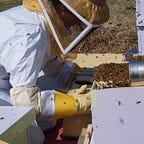What’s The Draw? Getting Butterflies and Bees to Your Garden This Spring
Gardeners are getting giddy as spring is upon us. The warmer weather not only frees people up to spend time outside, but this is a special and favorite time of year for gardeners and beekeepers. The excitement of the different blooms and busy pollinator activity is enough to lift a person’s spirits. Every gardener is dedicated to their craft, but some wonder how they may have more success drawing in more beautiful butterflies and buzzing bees this spring. All pollinators are wild, so there is no guaranteed way to draw the exact pollinators you want for your garden, but there are tried-and-true things one can do to increase the chances of seeing more flittering and fluttering over the next few months.
Don’t Overthink It, and Don’t Overdo It
You’ve driven by the meticulous lawns that appear to be personally manicured and those that seem only to get a periodic mow. Although those magazine-ready lawns may be aesthetically flawless, that is not a massive draw for bees, butterflies, and other pollinators. A little overgrowth, or some areas left free to grow some wildflowers, is something that means easy food for pollinators, and they will literally eat it up. There are ways to make your garden bee and butterfly-friendly without overthinking it and overdoing it. Gardens become natural spaces for bees and butterflies to find food, shelter, water, and nutrition. Gardeners do not have to choose between gorgeous landscaping and natural havens for bees and butterflies. It is possible to have both, and the less you overthink it and leave a little to grow wild, the more pollinators will be able to use your space.
Using Native Plants to Draw Local Pollinators
When planning your garden, it is wise to find out what plants and trees are native to the area. Although some species of plants adapt and become more native than invasive, native plants will closely match what pollinators need, and that is why many garden societies encourage gardeners to use native plants in their gardens, especially those wanting to get the lovely experience of frequent flittering visitors.
Clump blooms can be planted in individual flowers and plants, adding to the beauty and color while providing an excellent resource for bees and butterflies. Milkweed attracts monarch butterflies, and since this species is on the decline, as well as several bee species, finding room in your garden for a local variety is a huge help. Milkweed used to be regularly used in agriculture, but it is phasing out. Milkweed is where Monarchs lay their eggs, so declining areas to lay eggs means a decline in the species’ population. Providing quality food sources for bees and butterflies beautifies your garden and helps the environment, and milkweed gives off incredible scents during the spring!
Have Some Fun Creating a Safe Water Zone
Experienced gardeners and beekeepers know that bees can get most of what they need without our help. They also know bees appreciate safe water zones, where they can lap up some water and not drown. Bees can’t swim, and neither can butterflies. Typically, bees can collect enough water from the morning dew, but this is not an option in dry climates. A shallow pie pan with some twigs, rocks, or even a piece of sponge makes a great pit stop for pollinators. Bird baths, streams, and buckets also make great water spots, but it is critical to include things that bees and butterflies can perch upon.
Don’t Touch Those Pesticides and Tell Your Neighbors to Skip Them
When most people use pesticides, they try to get rid of something like ants or roaches. Rarely will someone try to get rid of bees and butterflies, but the side effect of pesticide use is that it poisons pollinators through the plants and flowers from which they draw their pollen and nectar. Even if you use pesticides away from your garden, the chemicals can adversely affect your garden’s health and free roaming pollinators. Believe it or not, even your neighbors’ use of pesticides can impact your pollinator visitors, so encourage your neighbors to steer clear of pesticides and go for some natural deterrents.
As we get ready for spring, it is a perfect opportunity to add a little something to your garden that is a draw for bees and butterflies. Whether leaving some of your landscaping a smidge wild, adding some native plants and milkweed, or making a fun water hang out, these small efforts may become part of your annual garden-prep, and you can enjoy the benefits for months to come.
Asking a local beekeeper about bees in your area can help you choose plants that attract pollinators. Always use pesticide alternatives, which requires using a professional humane live bee removal company if you ever encounter a beehive that poses a risk to people.
